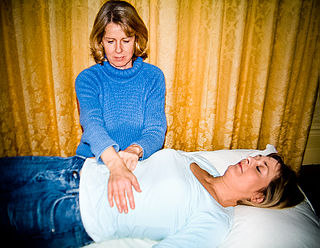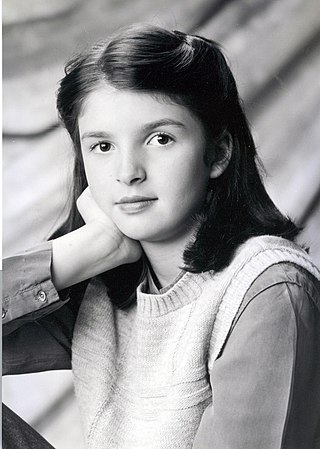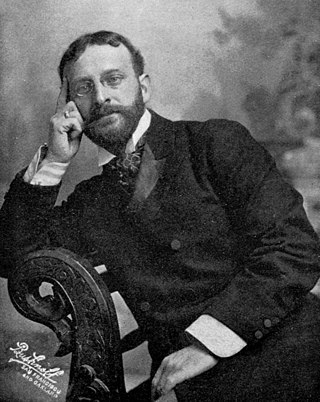Related Research Articles

The Diagnostic and Statistical Manual of Mental Disorders is a publication by the American Psychiatric Association (APA) for the classification of mental disorders using a common language and standard criteria. It is the main book for the diagnosis and treatment of mental disorders in the United States and is considered one of the principal guides of psychiatry, along with the International Classification of Diseases ICD, CCMD, and the Psychodynamic Diagnostic Manual. However, not all providers rely on the DSM-5 as a guide, since the ICD's mental disorder diagnoses are used around the world and scientific studies often measure changes in symptom scale scores rather than changes in DSM-5 criteria to determine the real-world effects of mental health interventions.

Reiki is a Japanese form of energy healing, a type of alternative medicine. Reiki practitioners use a technique called palm healing or hands-on healing through which, according to practitioners, a "universal energy" is transferred through the palms of the practitioner to the patient, to encourage emotional or physical healing.
Medical physics deals with the application of the concepts and methods of physics to the prevention, diagnosis and treatment of human diseases with a specific goal of improving human health and well-being. Since 2008, medical physics has been included as a health profession according to International Standard Classification of Occupation of the International Labour Organization.
Therapeutic touch, known by some as "non-contact therapeutic touch" (NCTT), is a pseudoscientific energy therapy which practitioners claim promotes healing and reduces pain and anxiety. "Therapeutic Touch" is a registered trademark in Canada for the "[s]tructured and standardized healing practice performed by practitioners trained to be sensitive to the receiver's energy field that surrounds the body;...no touching is required."
A nursing diagnosis may be part of the nursing process and is a clinical judgment about individual, family, or community experiences/responses to actual or potential health problems/life processes. Nursing diagnoses foster the nurse's independent practice compared to dependent interventions driven by physician's orders. Nursing diagnoses are developed based on data obtained during the nursing assessment. A problem-based nursing diagnosis presents a problem response present at time of assessment. Risk diagnoses represent vulnerabilities to potential problems, and health promotion diagnoses identify areas which can be enhanced to improve health. Whereas a medical diagnosis identifies a disorder, a nursing diagnosis identifies the unique ways in which individuals respond to health or life processes or crises. The nursing diagnostic process is unique among others. A nursing diagnosis integrates patient involvement, when possible, throughout the process. NANDA International (NANDA-I) is body of professionals that develops, researches and refines an official taxonomy of nursing diagnosis.
A medical classification is used to transform descriptions of medical diagnoses or procedures into standardized statistical code in a process known as clinical coding. Diagnosis classifications list diagnosis codes, which are used to track diseases and other health conditions, inclusive of chronic diseases such as diabetes mellitus and heart disease, and infectious diseases such as norovirus, the flu, and athlete's foot. Procedure classifications list procedure code, which are used to capture interventional data. These diagnosis and procedure codes are used by health care providers, government health programs, private health insurance companies, workers' compensation carriers, software developers, and others for a variety of applications in medicine, public health and medical informatics, including:
Readiness for enhanced therapeutic regimen management is a NANDA approved nursing diagnosis which is defined as "A pattern of regulating and integrating into daily living a program(s) for treatment of illness and its sequelae that is sufficient for meeting health-related goals and can be strengthened." It was introduced at the 15th NANDA conference in 2002. Purpose: This book is devoted to a discussion of nursing diagnoses, outcomes, and interventions for older persons. As such, the diagnoses selected for the volume are not exhaustive, but represent a severely underdeveloped knowledge base. We have chosen diagnoses that are most prevalent, most difficult to treat, and/or most in need of further development to inform practicing nurses and nursing students and to improve the quality of life of older persons.
NANDA International is a professional organization of nurses interested in standardized nursing terminology, that was officially founded in 1982 and develops, researches, disseminates and refines the nomenclature, criteria, and taxonomy of nursing diagnoses. In 2002, NANDA became NANDA International in response to the broadening scope of its membership. NANDA International published Nursing Diagnosis quarterly, which became the International Journal of Nursing Terminologies and Classifications, and then later was reconceptualized as the International Journal of Nursing Knowledge, which remains in print today. The Membership Network Groups foster collaboration among NANDA-I members in countries and for languages: the German Language Group and the Dutch Language Group.

The nursing process is a modified scientific method which is a fundamental part of nursing practices in many countries around the world. Nursing practise was first described as a four-stage nursing process by Ida Jean Orlando in 1958. It should not be confused with nursing theories or health informatics. The diagnosis phase was added later.

Emily Rosa is the youngest person to have a research paper published in a peer reviewed medical journal. At age nine Rosa conceived and executed a scientific study of therapeutic touch which was published in the Journal of the American Medical Association in 1998. She graduated from the University of Colorado at Denver in 2009 with a major in psychology. Her parents, Larry Sarner and Linda Rosa, are leaders of the advocacy group Advocates for Children in Therapy.

Applied kinesiology (AK) is a pseudoscience-based technique in alternative medicine claimed to be able to diagnose illness or choose treatment by testing muscles for strength and weakness.

Ego-dystonic sexual orientation is a highly controversial mental health diagnosis that was included in the American Psychiatric Association's Diagnostic and Statistical Manual of Mental Disorders (DSM) from 1980 to 1987 and in the World Health Organization's (WHO) International Classification of Diseases (ICD) from 1990 to 2019. Individuals could be diagnosed with ego-dystonic sexual orientation if their sexual orientation or attractions were at odds with their idealized self-image, causing anxiety and a desire to change their orientation or become more comfortable with it. It describes not innate sexual orientation itself, but a conflict between the sexual orientation a person wishes to have and their actual sexual orientation.
Energy medicine is a branch of alternative medicine based on a pseudo-scientific belief that healers can channel "healing energy" into a patient and effect positive results. The field is defined by shared beliefs and practices relating to mysticism and esotericism in the wider alternative medicine sphere rather than any sort of unified terminology, leading to terms such as energy healing or vibrational medicine being used as synonymous or alternative names. In most cases there is no empirically measurable energy involved: the term refers instead to so-called subtle energy. Practitioners may classify the practice as hands-on, hands-off, and distant where the patient and healer are in different locations. Many schools of energy healing exist using many names: for example, biofield energy healing, spiritual healing, contact healing, distant healing, therapeutic touch, Reiki or Qigong.
The classification of mental disorders, also known as psychiatric nosology or psychiatric taxonomy, is central to the practice of psychiatry and other mental health professions.

Radionics—also called electromagnetic therapy (EMT) and the Abrams Method—is a form of alternative medicine that claims that disease can be diagnosed and treated by applying electromagnetic radiation (EMR), such as radio waves, to the body from an electrically powered device. It is similar to magnet therapy, which also applies EMR to the body but uses a magnet that generates a static electromagnetic field.
The Nursing Outcomes Classification (NOC) is a classification system which describes patient outcomes sensitive to nursing intervention. The NOC is a system to evaluate the effects of nursing care as a part of the nursing process. The NOC contains 330 outcomes, and each with a label, a definition, and a set of indicators and measures to determine achievement of the nursing outcome and are included The terminology is an American Nurses' Association-recognized terminology, is included in the UMLS, and is HL7 registered.
Spiritual distress is a disturbance in a person's belief system. As an approved nursing diagnosis, spiritual distress is defined as "a disruption in the life principle that pervades a person's entire being and that integrates and transcends one's biological and psychological nature."
Dora Kunz née Theodora Sophia van Gelder was a Dutch-American writer, psychic, alternative healer, occultist and leader in the Theosophical Society in America. Kunz's works have been widely published in Dutch, English, French, German, Polish, Portuguese, and Spanish.
The Clinical Care Classification (CCC) System is a standardized, coded nursing terminology that identifies the discrete elements of nursing practice. The CCC provides a unique framework and coding structure. Used for documenting the plan of care; following the nursing process in all health care settings.
References
- ↑ Human Energy Fields - Healing Methods
- 1 2 "DEFINING THE KNOWLEDGE OF NURSING: Priorities for Terminology Development". NANDA. Archived from the original on 20 August 2014. Retrieved 19 August 2014.
- ↑ NANDA International, Inc. Nursing Diagnoses: Definitions & Classification 2015-2017 (10th ed.). Eds. T Heather Herman & S. Kamitsuru. Oxford: Wiley Blackwell.
- ↑ NANDA International, Inc. nursing diagnoses : definitions & classification 2018-2020. Herdman, T. Heather,, Kamitsuru, Shigemi, 1961-, North American Nursing Diagnosis Association (Eleventh ed.). New York. 2018. ISBN 9781626239296. OCLC 990288599.
{{cite book}}: CS1 maint: location missing publisher (link) CS1 maint: others (link) - ↑ "Changes to NANDA Nursing Diagnosis List 2018-2020". 10 February 2018.
- ↑ "NANDA 2018-2020, preview".
- ↑ therapeutic touch - The Skeptic's Dictionary - Skepdic.com
- ↑ Why Therapeutic Touch Should Be Considered Quackery